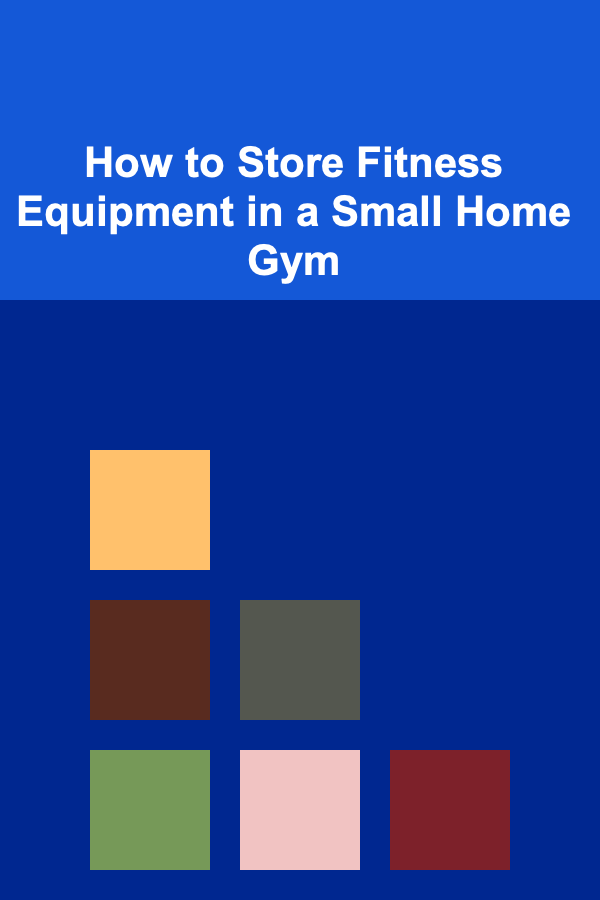
How to Store Fitness Equipment in a Small Home Gym
ebook include PDF & Audio bundle (Micro Guide)
$12.99$6.99
Limited Time Offer! Order within the next:

Setting up a home gym is one of the best investments you can make for your health and well-being. However, when space is limited, storing fitness equipment becomes a challenge. In a small home gym, maximizing the available space and keeping everything organized is key to creating a functional, clutter-free workout area. Whether you are dealing with dumbbells, kettlebells, resistance bands, or large equipment like treadmills, storage solutions are essential for ensuring your space remains usable and aesthetically pleasing.
In this article, we'll explore various strategies and solutions for storing fitness equipment in a small home gym. From using vertical space to utilizing multifunctional furniture, we will look at ways to optimize your gym area for both organization and accessibility.
Declutter and Prioritize
The first step in organizing a small home gym is to assess your fitness equipment and declutter. Often, people accumulate fitness equipment over time, and some pieces may no longer serve their purpose or might be used infrequently. Decluttering is crucial for ensuring you make the most out of the space you have.
Sort and Assess Your Equipment
Take inventory of all the fitness equipment you own. Break it down into categories such as:
- Small Equipment: Dumbbells, kettlebells, resistance bands, jump ropes, yoga mats, medicine balls, etc.
- Medium Equipment: Weights, exercise benches, kettlebell racks, stability balls, foam rollers, etc.
- Large Equipment: Treadmills, stationary bikes, rowing machines, ellipticals, or any bulky, heavy equipment.
Next, evaluate how frequently you use each item. If there are pieces that you don't use often, consider storing them out of sight or even donating or selling them to free up space. By determining which items you use regularly and which are only occasionally used, you can prioritize their storage location.
Limit the Equipment You Keep
Once you have decided which equipment you want to keep, consider how you can limit the amount of gear. For example, if you own multiple sets of dumbbells or resistance bands, you might choose to keep only the most essential or versatile items. Alternatively, look into multipurpose equipment that can serve multiple functions, such as adjustable dumbbells or a multi-gym system that combines several machines into one piece.
Maximize Vertical Space
In a small home gym, utilizing vertical space is one of the most effective ways to store equipment without taking up valuable floor space. By installing wall-mounted racks, shelves, or hooks, you can store items in a way that is both efficient and easily accessible.
Wall-Mounted Racks
One of the most practical and popular solutions for storing small to medium fitness equipment is using wall-mounted racks. These can hold dumbbells, kettlebells, or even smaller storage bins. Wall-mounted racks allow you to take advantage of your walls without sacrificing floor space.
- Dumbbell Racks: Wall-mounted dumbbell racks can keep your dumbbells neatly organized and off the floor. Choose a rack that suits the size and weight of your dumbbells to ensure stability and safety.
- Kettlebell Racks: Kettlebells tend to be heavy and take up a lot of space, but a wall-mounted rack can neatly store them in a vertical arrangement, freeing up valuable floor space.
- Small Equipment Hooks: For items like resistance bands, jump ropes, and yoga mats, use sturdy hooks or pegs on the wall to keep them organized and easily accessible.
Shelving Units
Installing shelves on your walls is another great way to store smaller items like medicine balls, foam rollers, and even small storage bins that house accessories like weight collars or chalk. Floating shelves can add a decorative element while still being functional for storage.
- Adjustable Shelves: These allow you to customize the height of each shelf depending on the size of the equipment you need to store. They are perfect for keeping your gym essentials within reach, especially if you have varied equipment sizes.
- Corner Shelves: For underutilized spaces, such as corners, corner shelves can help you store lighter, smaller items like yoga props or recovery tools.
Pegboards
If you are looking for a more customizable and versatile storage solution, consider installing a pegboard. Pegboards can hold a variety of items by simply adding hooks, baskets, or shelves. You can store things like resistance bands, jump ropes, gloves, towels, or even workout attire. The ability to rearrange hooks and shelves on a pegboard makes it ideal for a growing collection of gym accessories.
Use Multifunctional Furniture
In small spaces, multifunctional furniture is a game changer. Using items that serve more than one purpose helps you maximize the utility of your space while keeping things organized.
Storage Benches
Storage benches are a great addition to any home gym, offering both seating and storage in one compact piece of furniture. Look for benches with hidden compartments where you can store smaller fitness gear like resistance bands, weights, or jump ropes. If your gym area is part of a larger living space or a converted bedroom, a storage bench can double as a place to relax or put on shoes.
Foldable or Collapsible Equipment
Some fitness equipment is designed to be foldable or collapsible, which can save a significant amount of space when not in use. For example:
- Foldable Exercise Bench: A foldable bench can be tucked away when not in use, freeing up floor space for other activities.
- Collapsible Cardio Equipment: Machines like folding treadmills or ellipticals can be folded and stored against the wall when not in use.
- Foldable Yoga Mats: Many yoga mats come with foldable designs or carry bags that can make them easy to store in a small space.
By investing in foldable or collapsible fitness equipment, you can ensure that your home gym area remains functional without taking up unnecessary space when not in use.
Ottomans with Storage
Similar to storage benches, ottomans with built-in storage are a stylish and practical solution for a small home gym. You can use them to store things like dumbbells, weights, or small exercise equipment. They can also serve as seating or as a place to rest between sets.
Consider Modular and Stackable Storage Solutions
Modular storage units are an excellent option for small gyms. They allow you to customize your storage to fit your specific needs and available space. Stackable storage bins or baskets are another good solution that can be stacked on top of each other to keep things organized.
Stackable Bins
Stackable bins are great for storing smaller items like resistance bands, ankle weights, and foam rollers. Label each bin so that you can easily identify the contents, and stack them vertically to save space. You can store the bins under shelves or in cabinets, allowing you to keep the space organized while also reducing clutter.
Modular Shelving Units
Modular shelving systems are versatile and can be adapted to your gym's changing needs. Whether you need more storage space for weights, yoga accessories, or towels, modular units can be rearranged to fit your space. Many systems offer adjustable heights, giving you more flexibility in how you store your equipment.
Rolling Carts
A rolling cart can help organize smaller items that you use regularly in your workout routine, such as resistance bands, medicine balls, or fitness trackers. These carts are portable, making it easy to move equipment from one area of your gym to another.
Hide Large Equipment
When it comes to larger pieces of fitness equipment, such as treadmills or stationary bikes, you need creative storage solutions to keep them out of the way when they are not in use. While some people may prefer to keep their gym equipment in plain sight, others may want to hide it to maintain the aesthetic of the room.
Use a Privacy Screen or Divider
If you're working with a limited space, you can use a room divider or privacy screen to hide bulky fitness equipment when it's not in use. These dividers can create a distinct workout zone within a larger room and can easily be moved when you want to access your equipment.
Create a Dedicated Gym Closet
If your home has a closet or a storage room, consider turning it into a small gym area. Store your larger fitness equipment inside, and use shelves or hooks for smaller items. This is an ideal option if you want to keep everything hidden away but still within easy reach when you're ready to exercise.
Maintain an Organized Routine
Once you have established your storage solutions, it's important to maintain organization in your gym. A cluttered gym is not only frustrating but can also be a safety hazard.
Regularly Rotate Equipment
If you store seasonal equipment or items that you don't use frequently, make sure to rotate them regularly to ensure that everything stays organized. For example, if you're using your treadmill more in the winter, move other equipment to the back or sides of the room to make space for it.
Clean and Organize Periodically
Regularly cleaning and organizing your gym equipment is essential for maintaining a safe and inviting workout space. Wipe down machines, vacuum floors, and organize your smaller accessories to prevent dust or dirt buildup.
Create a Cleaning Schedule
Create a weekly or monthly cleaning schedule to ensure that your home gym stays in top condition. Cleaning your equipment after each use can help it last longer and ensure a pleasant experience each time you work out.
Conclusion
Storing fitness equipment in a small home gym requires creativity and thoughtful organization. By utilizing vertical space, investing in multifunctional furniture, and implementing modular storage solutions, you can create an efficient, clutter-free workout environment. With the right storage strategies in place, you'll have a gym that is both functional and aesthetically pleasing---one that allows you to make the most of your limited space while enjoying a great workout experience.
Remember that organization is an ongoing process. Periodically reassess your storage needs, declutter, and maintain a routine to keep your gym organized and ready for every workout.

How to Identify High-Growth Investment Opportunities
Read More
How to Keep Your Home Smelling Fresh All the Time
Read More
How to Make Your Own Wall Art to Save Money on Decor
Read More
How to Sell Personalized Wedding Favors on Etsy: An Actionable Guide
Read More
How to Use Drawer Dividers for Effective Storage
Read More
Software Engineer's Blueprint: Leveraging Design Patterns and Best Practices for Efficiency
Read MoreOther Products

How to Identify High-Growth Investment Opportunities
Read More
How to Keep Your Home Smelling Fresh All the Time
Read More
How to Make Your Own Wall Art to Save Money on Decor
Read More
How to Sell Personalized Wedding Favors on Etsy: An Actionable Guide
Read More
How to Use Drawer Dividers for Effective Storage
Read More